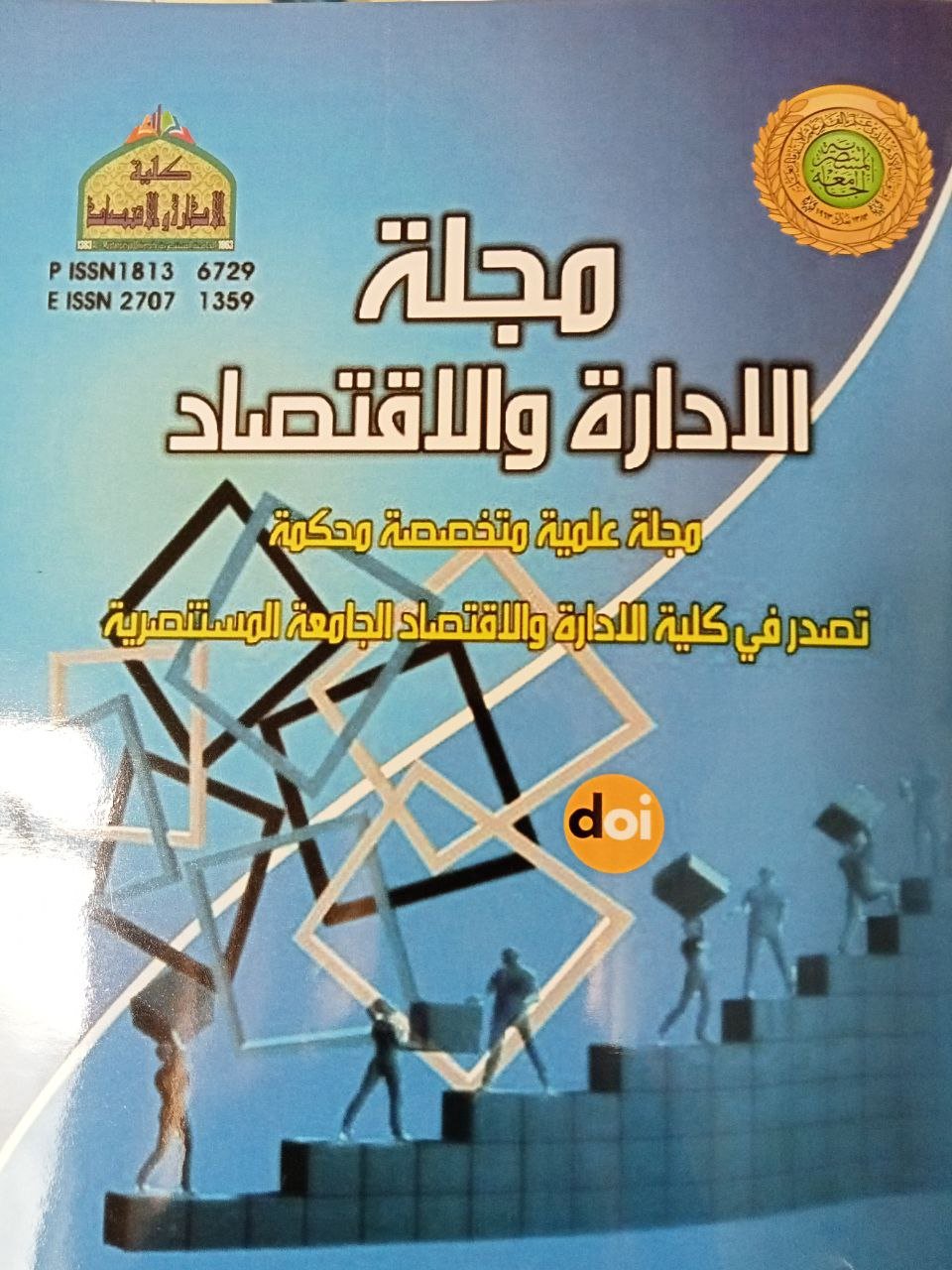THE EFFECT OF CYBERLOAFING BEHAVIOR AND ORGANIZATIONAL COMMITMENT ON JOB PERFORMANCE (Applied Research on Al- Mustansiriya University employees and academics)
DOI:
https://doi.org/10.31272/jae.i142.1045الكلمات المفتاحية:
Cyber loafing، Organizational commitment، job performanceالملخص
The aim of this research is to learn more about cyberloafing and organizational commitment and how it affects employee performance.
The community in this study consists of employees, Masters, experts and specialized bodies from Al-Mustansiriya University from all departments.
This research is a descriptive correlation research method.
To collect data, a questionnaire consisting of 50 questions was used, which was collected for (270) administrative and academic employees who use the Internet and computers, and the Likert 5 coding option was also used.
It is essential to allow the employee to rest and participate in competitive activities.
Employers who abandon Internet services such as web browsing and social networking will see an increase in the work processes and efforts of their employees.
It is concluded from this that The effects of CYG on organizations can range from partial distraction for employees, to a serious waste of company resources.
Our study suggests that if an employer wants to reduce employees' CYG behaviour, it is helpful to pursue strategies that counter their ability to deceive others.
Focusing on responsibility and punishment deters them from this behaviour.
Management can tell employees that all their online activities are being monitored, but beware that such monitoring may violate employees' privacy, creating an undesirable work environment.
The CYG phenomenon is not evil. Surfing the Internet at work can have a positive impact on employees' emotions, as it allows them to relieve work stress.
It can also support productivity in some cases, by providing rest periods for employees that enable them to regain their focus and activity.
While employees allow themselves to engage in some online activities during work hours, work may also extend beyond their desks into their personal lives.
التنزيلات
المراجع
Aladwan, M. M. (2021). Cyberloafing as a mediating variable in the relationship between workload and organizational commitment. Management Science Letters,: 11(3).
Alipour, Z. M. (2014). Comparing topological and reliability-based vulnerability analysis of Ira power transmission network. Proceedings of the Institution of Mechanical Engineers, Part O. 228: Journal of Risk and Reliability,.
Aghaz, A., & Sheikh, A. (2016). Cyberloafing and job burnout: An investigation in the knowledge-intensive sector. Computers in Human Behavior, 62, 51-60.
Ahmadi, H., Bagheri, F., Ebrahimi, S. A., Rokni, M. A. N., & Kahreh, M. S. (2011). Deviant work behavior: Explaining the relationship between organizational justice and cyber-loafing as a deviant work behaviour. American Journal of Scientific research, 24(103-116).
Aladwan, M., Muala, I., & Salleh, H. (2021). Cyberloafing as a mediating variable in the relationship between workload and organizational commitment. Management Science Letters, 11(3), 1013-1022.
Almansoori, M. R.-T. (2021). . The mediating role of organizational leadership and sustainability between strategic planning and the performance of UAE governmental organizations 2289-2296..
Anandarajan, M. &. (2004). Constructive and dysfunctional personal web usage in the workplace: mapping employee attitudes. In Personal web usage in the workplace: A guide to effective human resources management. IGI Global. (pp. 1-27)
Andersen, L. L. (2016). Physical workload and risk of long-term sickness absence in the general working population and among blue-collar workers:. prospective cohort study with registered follow-up. Occupation. 73(4), 246-253.
Blanchard, A. L. (2008). Correlates of different forms of cyberloafing: The role of norms and external locus of control. Computers in human behavior,. 24(3).
Beugre, C. D., & Kim, D. (2006). Cyberloafing: vice or virtue?. book, Emerging Trends and Challenges in Information Technology Management, 834-835.
Blau, G., Yang, Y., & Ward-Cook, K. (2006). Testing a measure of cyberloafing. Journal of Allied Health, 35(1), 9-17.
Campbell, J. P. (1990). Modelling the performance prediction problem in industrial and organizational psychology. In M. D. Dunnette & L. M. Hough (Eds.), Handbook of Industrial and Organizational Psychology . . Palo Alto, CA:: Consulting Psychology.
Campbell, J. P. (1993). A theory of performance. Personnel selection in organizations. ds. (2222). sg.
Cox, S., Goette, T., & Young, D. (2005). Workplace surveillance and employee privacy: Implementing an effective computer use policy. Communications of the IIMA, 5(2), 6.
D'Abate, C. P. (2005). Working hard or hardly working: A study of individuals engaging in personal business on the job. Human relations, 58(8), 1009-1032.
Goold, B. J. (2010). How much surveillance is too much? Some thoughts on surveillance, democracy, and the political value of privacy. democracy, and the political value of privacy.
Grueso Hinestroza, M. P. (2010). mplementation fo good practices for promotion of personnel and their relationship with the organization's commitment and culture. Innova. 20(36),.
Hameed, I. &. (2021). ocial Sciences and Humanities . Global Journal of Management.
Hartijasti, Y. &. (2014). Cyberloafing across Generation X and Y in Indonesia. Journal of Information Technology Applications and Management. 21(1), p.1-16.
Henle, C. A. (2008). The interaction of work stressors and organizational sanctions on cyberloafing. Journal of managerial issues. 383-400
Jain, A. O. (2013). Commentary: The Materials Project: A materials genome approach to accelerating materials innovation. APL materials. 1(1),.
Junco, R. (2012). The relationship between multiple indices of Facebook use and academic performance. Too much face and not enough books, Computers in human behaviour,: 28(1).
Lew, T. Y. (2011). Understanding the antecedents of affective organizational commitment and turnover intention of academics in Malaysia: The organizational support theory perspectives. . African Journal of Business Management, 5(7),.
Lim Vivien K.G. and Don J.Q., C. (2012). Cyberloafing at the Workplace: Gain or Drain on work?”, Behaviour and Information Technology. Vol.31, No.4,.
Grieve & Lowe-Calverley, E. &. (2017). cyberloafing they think they can get away with it, so employers need to get creative. Some workers.
Krishnan, S., & Lim, V. K. (2010). Moderating effects of extroversion and neuroticism on sleep deprivation and cyberloafing.
Makan, A. (1995). Power for women and men: towards a gendered approach to domestic energy policy and planning in South Africa. Third World Planning Review.
Malhotra, N. (2014). A Hand–On Orientation. Prentice Hall/Financial Times. (F. Edition, Ed.) Essentials of Marketing Research:.
Meyer, J. P. (1991). A three-component conceptualization of organizational commitment. Human resource management review, 1(1),.
Murphy, K. R. (1988). Dimensions of job performance. Colorado State Univ Fort Collins.
Nosrati, A. &. (2021). The antecedents of job embeddedness and their effects on cyberloafing among employees of public universities in eastern Iran. Iran: International Journal of Islamic and Middle Eastern Finance and Management,.
Ozler, D. E., & Polat, G. (2012). Cyberloafing phenomenon in organizations: Determinants and impacts. International Journal of eBusiness and eGovernment Studies, 4(2), 1-15.
Park, B. S. (2014). The impact of mobile tablet devices on human information behaviour. Journal of Documentation. 70(4): 622-639.
Pindek, S. K. (2018). Cyberloafing as a coping mechanism: Dealing with workplace boredom. Computers in Human Behavior, 86.
Saeed, S. H. (2020). Malware detection in the industrial internet of things based on hybrid image visualization and deep learning model. (102154., Ed.) Hoc Networks, , .
Saleh, M. (2018). The effect of cyberloafing on employee productivity, International Journal of Advanced and Applied Sciences. 5(4)
Sardjana, E. S. (2019). The effect of remuneration, work discipline, motivation on performance, : International Journal of Multicultural and Multireligious Understanding.
Seymour, L. &. (2007). Web access for IT staff: . a developing world perspective on web abuse. : The Electronic Library. 25(5), 543-557.
Van Doorn, O. N. (2011)." Cyberloafing: A multi-dimensional construct placed in a theoretical framework". Van Doorn,. ON Eindhoven University of Technology The Netherlands. , 8(2), 472-477.
Zoghbi Manrique de Lara, P., Verano Tacoronte, D., & Ting Ding, J. M. (2006). Do current anti‐cyberloafing disciplinary practices have a replica in research findings? A study of the effects of coercive strategies on workplace Internet misuse. Internet Research, 16(4), 450-467.

التنزيلات
منشور
إصدار
القسم
الرخصة
مجلة الإدارة والاقتصاد هي مجلة مفتوحة المصدر حيث تكون جميع محتوياتها مجانية. تخضع مقالات هذه المجلة لشروط ترخيص المشاع الإبداعي المنسوب إلى المؤلف (CC-BY 4.0) (https://creativecommons.org/licenses/by/4.0/legalcode) الذي يسمح للمرخص لهم دون قيود بالبحث عن النص الكامل للمقالات أو تنزيله أو مشاركته أو توزيعه أو طباعته أو ربطه به، وفحصه للفهرسة وإعادة إنتاج أي وسيلة للمقالات بشرط أن ينسبوا إلى المؤلفين الفضل في ذلك (الاستشهاد). تسمح المجلة للمؤلفين بالاحتفاظ بحقوق الطبع والنشر لمقالهم المنشور.
. Creative Commons-Attribution (BY)









